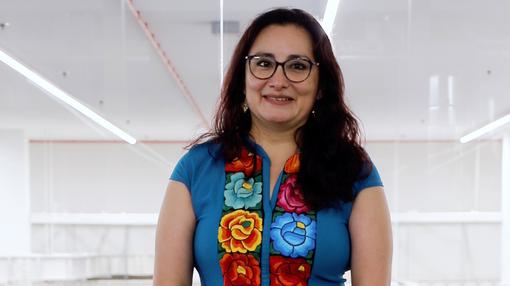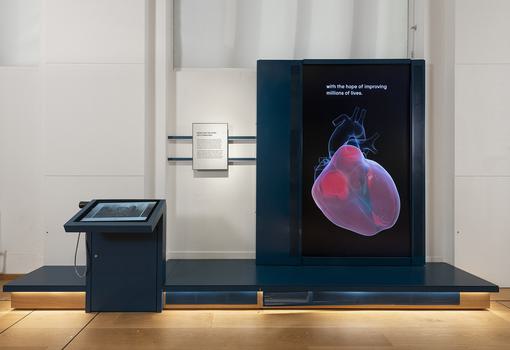World's first heart simulation goes live in the Engineers gallery

Categories: Engineers gallery
Today a complex and beautiful simulation of a beating human heart was unveiled in the Engineers gallery at the Science Museum. Created by bioengineer Dr Jazmin Aguado-Sierra using scans of her own heart, it shows the complex interactions between electrical impulses, muscle contraction and blood flow in the heart - a feat only possible using supercomputer power.
Dr Aguado-Sierra used her own data captured from sources including electrocardiographs that measured electrical impulses and Magnetic Resonance Imaging (MRI) scans of her heart tissues. The large data sets were then inputted into mathematical equations that described her heart’s workings and her virtual heart was brought to life by MareNostrum 4, a high-performance supercomputer based at Barcelona Supercomputing Center, to reproduce her heart in remarkable detail.
The simulation contains 5 billion data points, with each snapshot of her virtual heart changing every hundred thousandth of a second, which works at different length scales using distinct kinds of physics. If a human attempted to calculate them all, it would take almost 57 billion years to complete and analyse or interpret the findings. But using MareNostrum 4 and complex mathematical techniques employed by Dr Aguado-Sierra and her colleagues, it takes just 9 hours to solve.

Dr Jazmín Aguado-Sierra
The new model builds on earlier research and allows us to better understand this vital organ which beats 100,000 times a day to supply oxygen around the body. The calculations can be adjusted to simulate different heart conditions, showing why a heart beats too fast, too slow or irregularly. Doctors and researchers can also test treatments before they are used on patients, and in the future, digital twins of entire bodies could be made, transforming how we could predict, diagnose and treat illness.
Bioengineer Dr Jazmin Aguado-Sierra from Barcelona Supercomputing Center said: ‘The first time I saw my heart pumping it was fascinating! The fact that you can see it live on your screen being solved by a computer – that is you, and every characteristic is describing yourself. Supercomputing is changing the way modelling works and having access to my own data enriches the model that much faster. The more I learn about my heart, the more I will be able to produce new protocols or new tests, which is exciting for the future of predictive and personalised medicine.’
Dr Roger Highfield, Science Director, Science Museum Group, and co-author of the book Virtual You, said: 'All sorts of virtual organs are now being developed, with the heart the most sophisticated and personalised of all. We can do virtual tests of new drugs, recreate blood flow around the body, plan delicate epilepsy surgery on the brain, even create virtual breaths and sneezes, as well as help replace the use of animals in research. This work on digital twin technology, like our new Virtual Heart display, marks the dawn of truly personalised and predictive medicine.'
Real world applications of this simulation range from clinical research, diagnosis of heart problems and testing new drugs, surgeries, and treatments. In the near future, learning algorithms could also analyse the performance of the heart as we age and which recognise unusual patterns that may indicate a need for treatment long before we are even aware of it, forecasting disease.
The life size Virtual Heart display will sit within the Bodies section of the Engineers gallery. This section examines collaborations between clinicians, medical engineers and patients, and showcases real-world solutions that place people and their bodies at the heart of precision engineering practice.
The Engineers gallery celebrates our engineering heritage and showcases innovations through the global lens of the Queen Elizabeth Prize for Engineering—the world’s leading award for engineers – with current and past prize winners featured throughout. The gallery is supported by the Queen Elizabeth Prize for Engineering (Major Funder) and MathWorks (Major Sponsor).


